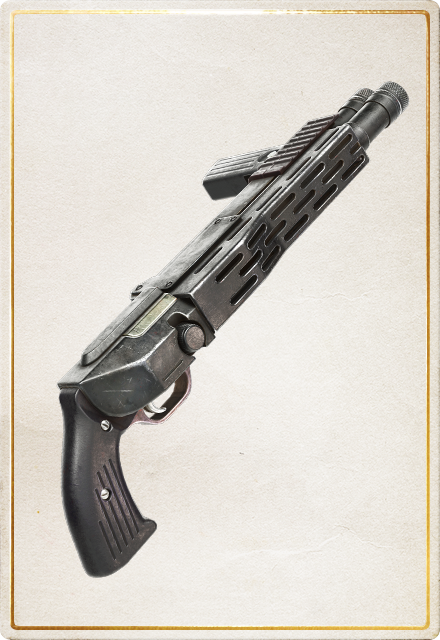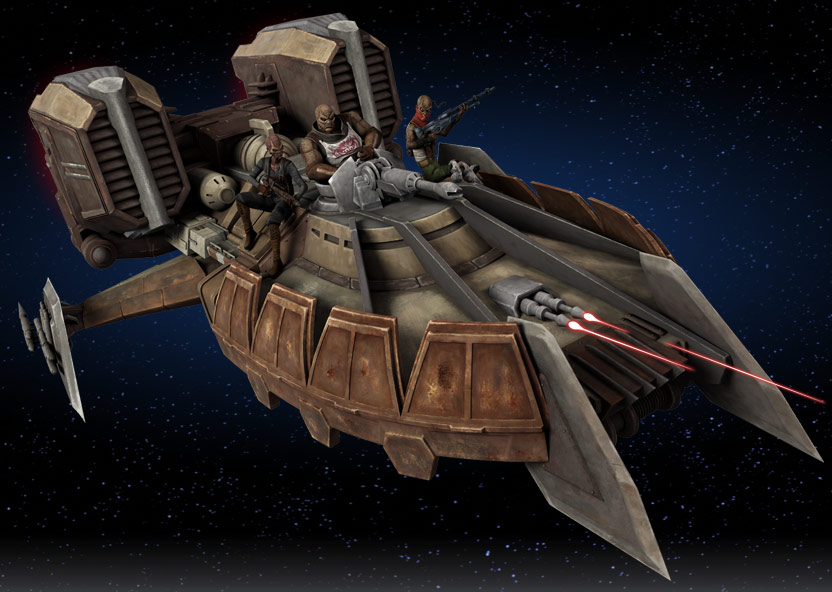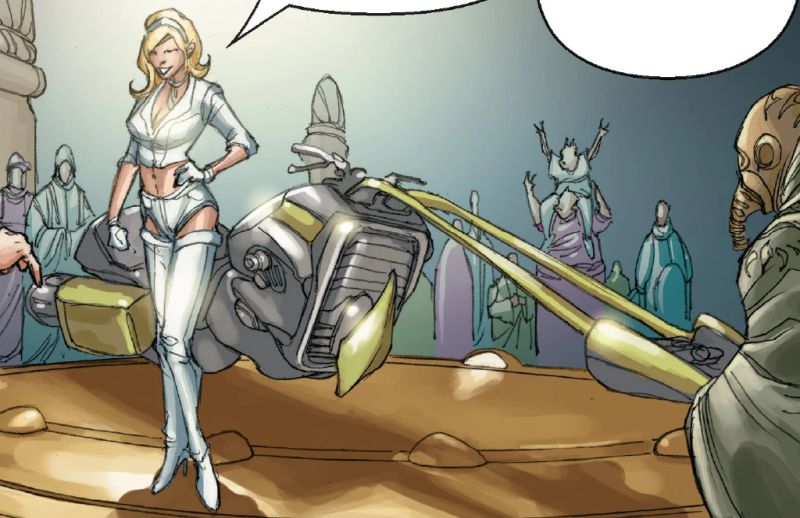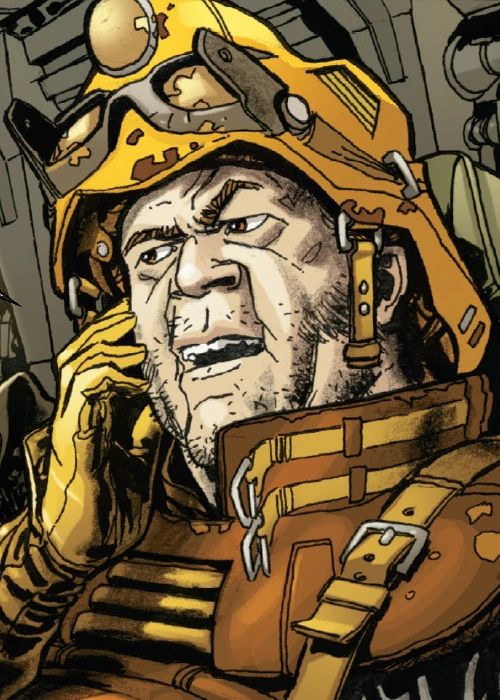 VANGUARD SCATTER GUN
Model: Vanguard Scatter Gun
Type: Slugthrower shotgun/scatter gun
Scale: Character
Skill: Slugthrowers: scatter gun
Ammo: 10
Cost: 500 (shells, pack of 10: 20)
-Solid Slugs: 40
-Incendiary Rounds: 30
-Shredder Rounds: 30
-Door Breaker Rounds: 30
-Ion Rounds: 40
-Stun Rounds: 40
-Ammo Magazine Mod: 100
Availability: 1, R
Fire Rate: 1
Range: 1-3/10/30
Damage:
-Single Barrel: 5D/4D/3D
-Double Barrel: 6D/5D/4D
GAME NOTES:
The Vanguard's damage lists three dice codes separated by "/". These are the damages that it does at short, medium, and long ranged, like most shotguns tend to do, especially in shooter video games like Battlefront II.
The Vanguard Scatter Gun, like most shotguns, is capable of using a variety of alternative ammunition shells to achieve a wide range of desired effects in combat. Prices for these are listed above, and they are purchased in packs of 10.
-Solid Slugs: The scatter gun is named as such because its ammunition propels a mass of small pellets out the barrel, which do damage as long as they stay bunched together when fired, as they "scatter" out the barrel, then potentially "scatter" whatever or whoever they hit. They lose damage when the pellets "scatter" further apart over distance. When replacing these pellet shells with solid slugs, these tend to do much more damage than pellet shells. These slugs tend to be rather large, larger than most slugthrower rounds, and having enough propellant behind them to deal massive damage. When using solid slugs, the scatter gun's damage is +1D, and the range is 2-5/15/45m.
-Incendiary Rounds: The shells' pellets are replaced with a flamable material that ignites and releases a spewing jet of flame from the scatter gun per round, buring flesh and armor on contact. Damage is 4D/3D/2D, but the anything touched by the flames stays on fire for 2D rounds with damage being rolled every round unless the fire is put out. Range is 1-2/6/12m.
-Shredder Rounds: These rounds have the shell's pellets relplaced with materials better suited to shredding softer materials like skin and muscle instead of punching armor. They do +1D damage to such materials, but -1D to armor, vehicles, droids, etc.
-Door Breaker Rounds: Where shredder rounds are best against soft targets, these are best at punching through hard materials, but don't do so well against people. +1D against armor, droids, vehicles, etc, but -1D to soft targets.
-Ion Rounds: A shotgun shell has plenty of room in it to contain materials that can discharge a great amount of energy, greater than the discharges of devoted ion blasters at times, though at the expense of ammo capacity. +1D ion damage vs technologically powered and computerized targets, but -2D against anything else (kind of like firing blanks up close).
-Stun Runds: Same as Ion Rounds, but to produce stun damage against flesh and blood beings.
Ammo Magazine Mod: While other types of shitguns and scatter guns may be available that have greater ammo capacity, these are often considered undesirable due to their cumbersome nature, and the fact that the Vanguard Scatter Gun often fills the needed niche of a shotgun rather nicely without carrying too much ammo or being too big, bulky, and heavy. Any time something else may be needed, blasters tend to fill those roles rather well. Still, some who use scatter guns in combat do find themselves needing more ammo on occasion. For this reason, the Vanguard has a simple mod kit that converts one of its barrels into an ammo magazine tube that feeds into the chamber of the other barrel. This doubles the Vanguard's ammo from 10 to 20, at the cost of the Double Barrel damage firing option for greater damage.
- - - - - - - - - -
DESCRIPTION:
The scatter gun was a powerful weapon that was used by the Rebel Alliance, Galactic Empire, the New Republic, and probably any other faction that felt its soldiers needed some extra punch when fighting up close and personal. It was lethal when shot at close range, and it could penetrate through deflector shields. However, at range the strength of the scatter gun's damage was drastically reduced. This, combined with slugthrowers' limits on ammo, is why this weapon isn't as common in the galaxy as blasters are. Still, not many blasters can match the raw punch of a scatter gun when up close, which is why these weapons still see use in parts of the galaxy, even in the militaries of the Old Republic, Separatist Droid Army, Galactic Empire, and New Republic.
Behind The Scenes
The scatter gun was introduced in Star Wars: Battlefront's first major expansion pack, The Outer Rim DLC. It is bought through the use of Hutt Contracts, and will only unlock after the player has achieved 40 kills using the CA-87 shock blaster and by using 20 Focus Fire charges.
The Scatter Gun also has many similarities as the ACP Array Gun from the Legends video game, Star Wars: Republic Commando. The two guns have the same physical appearance.
- - - - - - - - - -
GAME DESIGN NOTES:
The Vanguard Scatter Gun doesn't have any stats to go by, so I took the basic idea behind it, statted that out, then added some extra just for fun. Hopefully the result seems like a realistic shotgun (alternative ammo) with a Star Wars touch, and also hopefully this may look useful to some GM or player in their games.
Below, the guidelines for converting weapons from Battlefront II to Star Wars D6 is still there, though it has almost nothing to do with this write-up, and is only there to go with the batch of Battlefront II conversions.
Star Wars Battlefront II Conversions
Before getting into the long-winded explanation of converting weapons from Battlefront II from their game stats, I also wanted to add quickly that I am pulling the lore for these weapons from wherever I can find it, as some of these weapons don't have much said about them. If the info contradicts anywhere, my apologies, take and leave what you wish for your games. That now said....
I've been playing this game a bit now, it's fun, and I was inspired to take the weapon statistics in the game, and use them to make some conversions for rpggamer.org in case anyone wanted to use these weapons in their games, or if they already exist, then these write-ups could be used as alternatives. For example, in the case of the A280 blaster rifle, it is supposed to be a very modular and modifiable blaster rifle, and it will already have some of these variants listed here as they are in the game. If GMs/players do not like these conversions, or feel they need to choose between one version or the other, it's ok to change these conversions as desired, or pass on them all together as your group sees fit.
Weapons in Battlefront II have four stats we can use to convert to D6 rules: Cooling Power, Range, Rate Of Fire, and Damage, and each of these ranks between 1 to 10. To figure these out, we'll do them backwards, from Damage to Cooling Power, as Damage is the easiest to convert.
DAMAGE: To figure out these weapons' D6 damage dice, I take the Damage rank, convert it to be 3D at rank 1 (because 3D is the most common low end I remember ever seeing for blasters in Star Wars D6) and 6D at rank 10 (as 6D was the most common damage dice I remember seeing for more powerful single-fire blasters before getting into blasters that have rapid fire). For the ranks in between, just apply pips as Star Wars D6 commonly does (rank 1=3D, rank 2=3D+1, rank 3=3D+2, rank 4=4D, etc). This conversion gives the blaster's (or other weapon's) base damage for a single shot before accounting for any rapid fire from the Rate Of Fire stat.
RATE OF FIRE (ROF): This is also simple and straightforward. ROF rank 1 is a single shot. Any weapons with this rank are single-fire and need multiple actions to fire more shots, as per the Star Wars D6 rules for multiple actions. For every rank beyond 1, this counts as an extra shot fired from the weapon with each attack. To represent this, we make it as simple as possible, and look at Star Wars D6's rules for combined actions and fire-linked weapons. Every rank past 1 will add +1 pip to the damage. So a weapon with rank 4 Damage and rank 5 ROF does 5D+1 damage in D6 rules (4D base damage per single shot, but it does 5 shots per attack, so that damage is +4 pips, totaling at 5D+1). This means the weapons' ammo magazine will also be decreased this many shots for every attack action the player makes. GMs/players could have their weapon have a single-fire option to toggle between these fire options if they wish to conserve ammo (if they even keep track of ammo, more on that below).
RANGE: To figure out range, we take the Range rank, multiply this by 10, and the resulting number is the weapon's short range (Rank number x10, in meters). Medium range is this times 2 (Rank number x10, then x2, in meters), and long range will be times four (Range rank x10, then x4, in meters). As of this writing, my intention is to go ahead and make this part of the conversion a simple formula applied to all of these weapons for the sake of expediency. This may not fit every weapon, and I may make exceptions where needed with weapons that have unique features and qualities. The reason for this simple approach isn't because of laziness, it's more because....well, I was just looking at the blasters in my Star Wars D6 rulebook for ideas and comparisons, and though there are similar traits to some blaster types (pistols, carbines, rifles, repeating blasters, etc), their ranges still seem a bit mixed up between the different types. I suppose this was done for variety.
A simpler approach to Range is to look at the weapons presented in the Star Wars D6 rulebook, pick the weapon that most fits the weapon being converted here, and use that range for the converted weapon. This is up to GM discretion.
NOTE!: Everything stated above for Range is my attempt to just keep it simple. While using the weapons in the Star Wars D6 Rulebook as general examples of weapons and weapon types (blaster pistols, blaster rifles, etc), the method I would prefer to use to convert range would involve using the ranked stats from the game as a modifier to the ranges of the generalized weapons listed in the Star Wars D6 Rulebook. As to how to do that, I am not sure yet. Every time I look at it, it gets complicated, and seems like it will have to be on a case by case basis depending on the weapon.
COOLING POWER (CONVERTED TO AMMO): This trait is probably the most difficult to figure out. In Battlefront II, weapons do not have ammunition, as they all seem to have a nearly unlimited power supply. Instead, they have to cool down after firing so many shots (much like the Mass Effect game series did after the first game in the series). With how blasters in D6 have very high ammo in their stats, many GMs/players often don't even bother keeping track of their ammo and act as though their blasters have unlimited ammo. Going in favor of D6 rules having ammo, we can use "Cooling Power" to convert into a number for ammo.
The "simple" method here would be to compare these weapons to a similar weapon in the Star Wars D6 rulebook, and use the same ammo, such as: Hold-Out Blasters have ammo of 6 (or something under 10); Sporting Blasters, ammo of 50; Blaster Pistols, ammo of 100; Heavy Blaster Pistols, ammo of 25 (as they sacrifice ammo for the power boost to damage); Blaster Rifles, Blaster Carbines, and Sporting Blaster Rifles all have ammo of 100; Light Repeating Blasters, ammo of 25; Heavy Repeating Blasters, ammo of "unlimited" if plugged to a power source (fusion generator, see Star Wars Sourcebook for purchase options), otherwise they have ammo of 50.
NOTE!: Weapons that have higher damage with multiple shots to simplify rapid fire, every "1" from ammo will supply the power to this "rapid fire burst" when applying the collective damage dice for that weapons attack (Example: an E-Web does 8D damage, some sources say this damage has 8-10 shots in it, but there's no need to break this down into single shots for ammo consumption, and every use of the E-Web's 8D damage counts as a single attack, which counts as "1" from its ammo (if using a portable ammo magazine and not a fusion generator)). If GMs/players want their rapid fire weapons to have a single fire option, first they figure out how much damage the single fire shot does. Then, every "pip" between that lower damage and the full damage counts as a single "shot". This total number of "pips" between single fire damage and rapid fire full damage is used to multiply the weapon's ammo to figure out how much ammo there is for single fire shots. Just keep track of how many shots the rapid fire option takes of using this altered ammo number.
As an example, let's use the E-Web. The E-Web does 8D damage. If the E-Web fires 10 shots per attack, and each shot counts as a "pip" for fire-linking and combined actions rules, then -9 pips reduces this 8D damage to 5D damage per shot. This also means the E-Web's ammo (if using a portable ammo magazine instead of fusion generator) would be x10 as well if using single fire as an option now, and rapid fire would still consume 10 ammo when doing 8D damage.
So, as always, if GMs/players do not like the these conversion results, feel free to change these up as desired. Some general guidelines to go by that I used for these conversions include....
-Blaster Pistols are average strength (3D-4D), shorter ranged than most bigger blasters (120m), ammo around 100.
-Hold-Out Blaster Pistols tend to be the weakest pistols (3D-ish), shortest ranged (12m), little ammo (6), but easily concealable due to very small size.
-Sporting Blaster Pistols tend to still be weak (3D+), have better ammo (50) and range (60m) than Hold-Out Blasters, but not quite as good as normal Blaster Pistols.
-Heavy Blaster Pistols are stronger (4D-5D), but shorter ranged (50m, more short ranged than normal Pistols), and less ammo (25) than normal Blaster Pistols.
-Blaster Rifles are stronger than Blaster Pistols (4D-5D), have much better range (300m), but similar ammo (100).
-Sporting Blaster Rifles are described as generally the same as rilfes, but a bit smaller. However, the example given seems more like damage similar to a pistol (4D+) with the range and ammo of a rifle (slighty better range at 350m).
-Blaster Carbines are as strong as rifles (4D-5D) but have slightly less range than Rifles (250m).
-Targeting Blaster Rifles are effectively blaster sniper rilfes, with similar strength to Blaster Rifles (5D+) and better range (Blaster Rifle range x2 to x4 on average).
-Repeating Blasters are generally stronger than Rifles (6D-8D due to rapid fire) and simalarly ranged or better.
-Light Repeating Blasters are stronger than Rifles (6D+, rapid fire), have Rifle ranges (300m), and can be carried.
-Heavy Repeating Blasters are stronger still (7D-8D+, rapid fire), usually have better ranges than Rifles (500m), usually need tri-pods to be fired without penalty, usually found in weapons emplacements for vehicles/bunkers/etc, and may need a second person to carry a power source like a fusion generator for "unlimited ammo" (otherwise hey have their own ammo, which will probably be cumbersome, and have ammo between 25-50 or more). While these blasters are heavy and cumbersome, there are some cases where they can be portable, due to unique designs, modifications, or the carrier being exceptionally big and strong.
There are also some exceptions to these weapon types. For instance, any hard corp fan of Star Wars D6 probably remembers the Thunderer Heavy Blaster Pistol in Gundark's Fantastic Technology guide, a heavy blaster pistol that does 6D+2 damage with each single shot it fires, only having ammo for 25 shots, and though it is described as a heavy blaster pistol, its size would have it closer to a blaster carbine. If any of Battlefront II's weapons and gear seem unique like this, I hope I will give them the attention they require.
An example of this kind of weapon is the A280 blaster rifle. This blaster in the game has a ROF rank of 4, implying it does four shots per attack. But it obviously has a three-shot burst in game play, and even says so in the weapon's description. Since the gap between shots and damage is only 1 pip, it's easy enough to add this into the damage and be done with it, as all three shots combine together for a single damage dice code. But some weapons may wind up being trickier than this as i go into these conversions.
|












